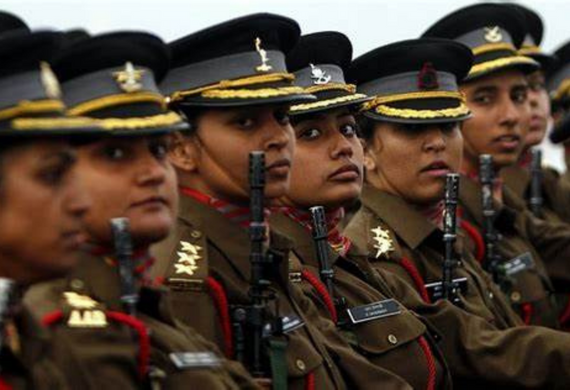
50 Women Officers to head Army units in advanced zones
By: GWL Team | Wednesday, 22 February 2023
Around 50 of these women officers will lead units in operational areas, with forward locations, in the strategically important Northern and Eastern Commands, which are in charge of policing India's borders with China. This is the Indian Army's first time assigning women officers to command roles outside the medical stream.
The change occurs a month after the army held a special selection board to elevate 108 female officers to the level of select-grade colonel to achieve gender parity, give them leadership positions in certain branches, and give them new, arduous identities. The board evaluated 244 female lieutenant colonels in total to fill the 108 openings.
According to one of the aforementioned officials who wished to remain anonymous, "Of the 108 women empanelled for career advancement to colonel by the selection board, those officers, who have cleared the necessary medical criteria, have now been placed in similar function assignments as their male counterparts as of February 20."
The female officers from the 1992 to 2006 batch who were evaluated by the selection board were commissioned in several different arms and services, such as engineers, signals, army air defence, intelligence corps, army service corps, army ordnance corps, and electrical and mechanical engineers.
According to a second official who also asked to not be identified, around 50% of the chosen women officers will be in charge of units that are stationed in active zones. Only when the army started giving women permanent commissions (PC) in 2020 was the opening of leadership jobs to women practicable.
"Once they started becoming PC, women were naturally promoted to command positions. Giving them a PC is incompatible with denying them some significant functions. According to former Northern Army commander Lieutenant General DS Hooda, "you have to be ready to offer them command responsibility in the branches they are serving in, and what's happening" (retd).
Almost 21-year Army Ordnance Corps veteran Lieutenant Colonel Sarita Satija (retd) stated the development has disproven the myth that women can't hold leadership positions. "That shows a shift in the system, but more significantly, in the way people think. It also puts women and men on an equal basis. In the future, I do not doubt that women will have even more responsibility," she continued.
Undoubtedly, female Army Medical Corps commanders have been in charge of field hospitals, military hospitals, and other healthcare facilities for many years. A few female physicians in the military have also attained the three-star level (lieutenant general and equivalent in the other two services).
General Manoj Pande, the head of the army, stated in January that the commissioning of female officers in the regiment of artillery was anticipated and emphasized that the army has achieved good strides in its priority area of women's empowerment.
The army sent Captain Shiva Chouhan, a woman officer, to Siachen, the highest and coldest combat in the world, in early January. It also sent 27 female peacekeepers, the largest number it has ever sent, to the disputed Abyei area of Sudan. There, they will help women and children in need and carry out security-related duties as part of a difficult assignment for the UN Interim Security Force (UNISFA). Tanks and infantry combat roles are still off-limits to women in the army, to be sure.
But, since it started inducting women as short-service commissioned officers in the early 1990s, the military has gone a long way. The three agencies are now providing women officers with a variety of options to empower them and close the gender gap by adopting a gender-neutral approach.
To promote gender equality within their ranks, the Indian Air Force and Navy now let women officers join its special forces organizations, the Garud Commando Force and Marine Commandos, as long as they match the requirements. Women are now participating in leadership positions on par with their male colleagues; women are training at the National Defense Academy, flying fighter jets, serving aboard warships, and are included in the people below officer rank (PBOR) cadre.
Most Viewed
- 1 Women's Health Startup HerMD Closing Doors Amid Industry Challenges
- 2 5 Famous Women in Indian Armed Forces
- 3 Saudi Women No longer Require Male Permission for Clothing Choices, says Prince MbS
- 4 Kolkata Medtech Startup Innovodigm Raises Rs 5.5 Crore Seed Funding Led by IAN Group
- 5 Yamunanagar's Kashish Kalra Honoured after Securing 111th Rank in UPSC Civil Services Exam
- 6 Madurai Appoints Its First Woman Corporation Head
- 7 IAS Vijayalakshmi Bidari Appointed as the new Nagpur Divisional Commissioner
- 8 American Entrepreneur Lucy Guo Overtakes T Swift to become Youngest Female Billionaire
- 9 ICC Women's World Cup 2025 Trophy Showcased at Indore's Holkar Stadium
- 10 Aparna Saxena's Beauty Venture AntiNorm Launches in India
- 11 Vidya Nataraj Co-Founded BlueStone Jewellery & Lifestyle files IPO
- 12 5 Women Freedom Fighters of India
- 13 Dr. G Krishnapriya appointed as CEO for Trichy
- 14 M3M & Sirona Partner to Introduce Menstrual Hygiene Vending Machines in 15 Locations
- 15 Punjab Govt launches SHE Cohort 3.0 Supporting Tech-led Women Startups
- 16 Indian origin Lawyer, Sweena Pannu appointed as the US New Superior Court Judge
- 17 The Aurora Tech Award recognizes 4 Indian Women-led Startups
- 18 Kerala's Republic Day parade featured an all-female tableau
- 19 Manisha Kabbur Becomes Karnataka's First Woman International Karate Coach
- 20 Director K. S. Ravikumar's Daughter Maalica Ravikumar Launches Life Coaching Company 'Evergrowth Academy' for Women
- 21 Leezu's Raises Pre-Seed Funding to Accelerate Growth in Sexual Wellness Industry
- 22 Sattu: Super-easy summer drink for PCOS gut healing
- 23 Swathi Nelabhatla creates Sitha App, India's First Women-Exclusive Gig Platform
- 24 7 Timeless Female Kathak Dancers & their Iconic Legacies
- 25 Meet 7 Iconic Women Architects of Modern India & their Most Impactful Work
- 26 This Woman-led Insuretech Startup is Helping Bridge the Education Financing Gap in India
- 27 Women Leaders Share Lessons Learnt from India Women's WC Win
- 28 5 Enterprising Women Founders Powering Singapore's Tech & Innovation Landscape
- 29 4 Women. 4 Stories. One Vision for Smarter, Stronger Healthcare
- 30 Global Gender Gap Narrows to 68.8%, But Full Equality 123 Years Away: WEF Report 2025
- 31 Changemakers: 7 Women Entrepreneurs Taking the Make in India Movement Forward
- 32 Meet Lucy Guo, The Youngest Self-Made Female Billionaire Disrupting Tech
- 33 How Women are Driving India's Festive Online Shopping Surge






